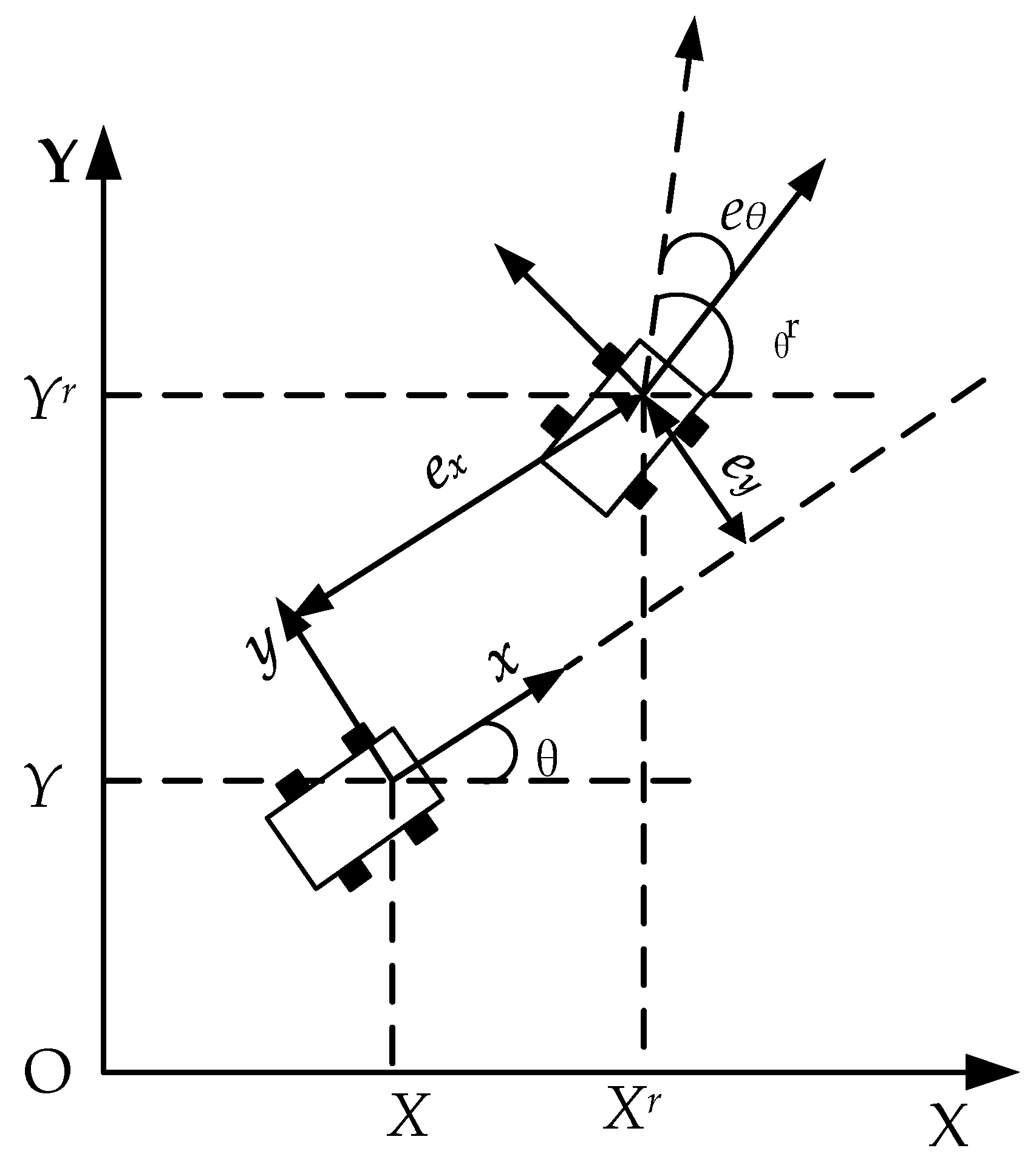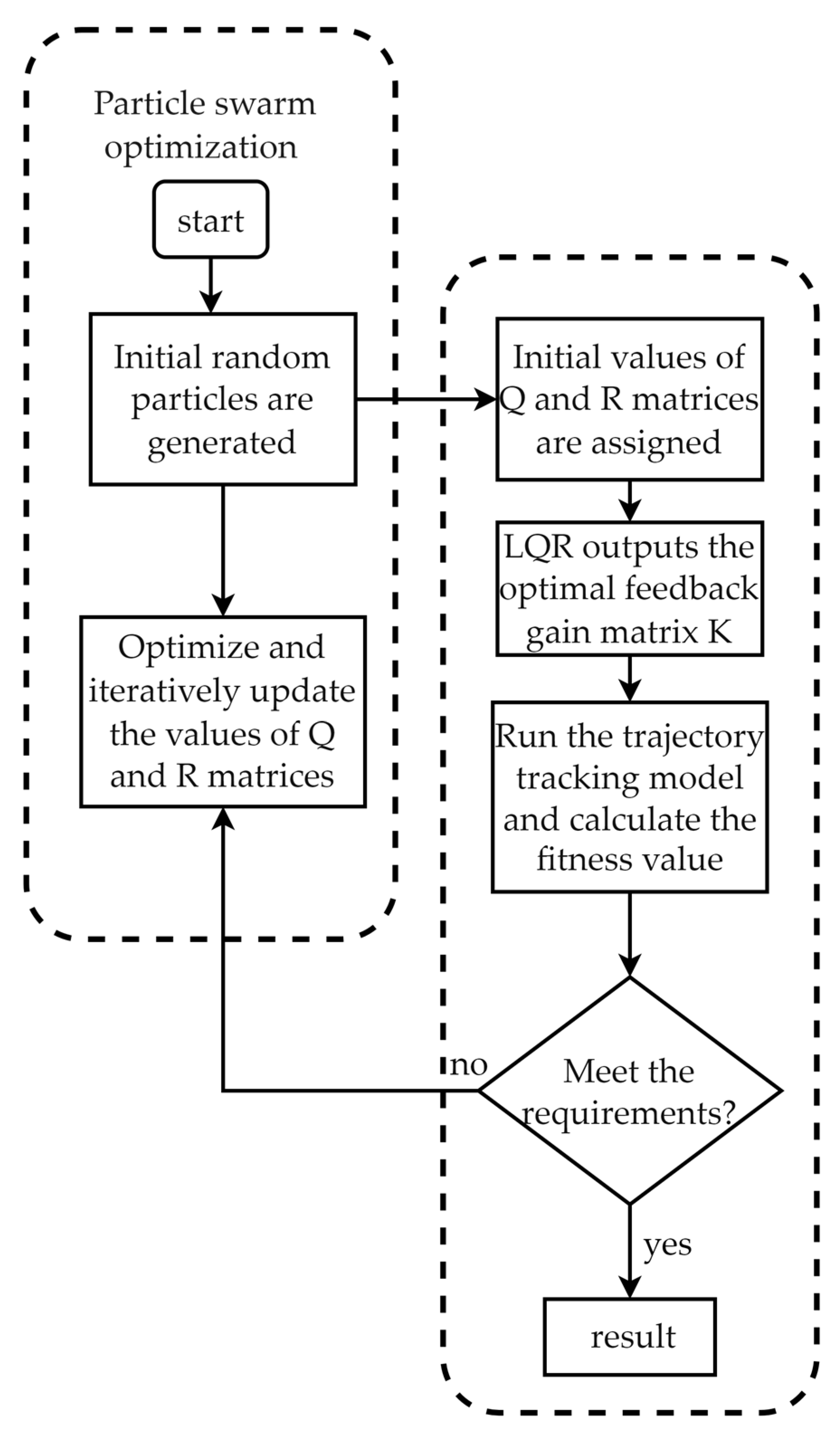PSO-Based Optimal Tracking Control of Mobile Robots with Unknown Wheel Slipping
Abstract
1. Introduction
- (1)
- To address the model mismatch problem introduced by unknown slipping parameters, a kinematic model incorporating longitudinal slipping dynamics is derived to characterize the system behavior, a sliding mode observer is used to observe the slipping parameter, and a first-order low-pass filter is used to reduce the chattering phenomenon.
- (2)
- To reduce reliance on empirical selection of LQR weights, a PSO algorithm with nonlinear inertia weights is proposed to optimize the Q/R matrix in real time to improve the tracking performance of the controller.
- (3)
- A closed-loop framework integrating slipping estimation and optimization control is constructed, significantly enhancing the tracking accuracy, control smoothness, and robust stability of WMRs with unknown slipping condition.
2. Kinematic Modeling with Slipping
3. Mobile Robot Trajectory Tracking Model
4. Slipping Estimation Using Sliding Mode Observer
4.1. Sliding Mode Observer Design
4.2. Proof of Sliding Mode Observer
5. LQR Control Design with PSO-Based Optimization
5.1. Linearization of System Equations
5.2. Enhanced PSO with Nonlinear Inertia Weight Strategy
6. Simulation Results
6.1. Circular Trajectory Simulation
6.2. Sine Wave Trajectory Simulation
7. Conclusions
Author Contributions
Funding
Data Availability Statement
Conflicts of Interest
References
- Chohan, J.S.; Bawa, G.; Hussain, A.; Al-Nafei, A.A.M.; Reddy, M.U.P.; Gehlot, A. Robotics and its control systems: Innovation overview and future challenges. In Proceedings of the 2024 11th International Conference on Computing for Sustainable Global Development (INDIACom), New Delhi, India, 28 February–1 March 2024; pp. 524–528. [Google Scholar] [CrossRef]
- Zhang, X.; Fang, Y.; Sun, N. Visual servoing of mobile robots for posture stabilization: From theory to experiments. IEEE Trans. Ind. Electron. 2017, 64, 390–400. [Google Scholar] [CrossRef]
- Cui, M.; Liu, H.; Liu, W.; Qin, Y. An adaptive unscented Kalman filter-based controller for simultaneous obstacle avoidance and tracking of wheeled mobile robots with unknown slipping parameters. J. Intell. Robot. Syst. 2018, 92, 489–504. [Google Scholar] [CrossRef]
- Park, B.S.; Yoo, S.J.; Park, J.B.; Choi, Y.H. Adaptive neural sliding mode control of nonholonomic wheeled mobile ro-bots with model uncertainty. IEEE Trans. Control Syst. Technol. 2009, 17, 207–214. [Google Scholar] [CrossRef]
- Zheng, W.; Zheng, J.; Shao, K.; Zhao, H.; Man, Z.; Sun, Z. Adaptive fuzzy sliding mode control of ucertain nnholonomic weeled mbile rbot with eternal dsturbance and atuator sturation. Inf. Sci. 2024, 663, 120303. [Google Scholar] [CrossRef]
- Chen, Y.H. Nonlinear Adaptive fuzzy hybrid sliding mode control design for trajectory tracking of autonomous mobile robots. Mathematics 2025, 13, 1329. [Google Scholar] [CrossRef]
- Chwa, D. Tracking control of differential-drive wheeled mobile robots using a backstepping-like feedback linearization. IEEE Trans. Syst. Man Cybern. A 2010, 40, 1285–1295. [Google Scholar] [CrossRef]
- Qiang, L.; Tang, H.H.; Ahmad, N.S. Improving Trajectory tracking of differential wheeled mobile robots with enhanced GWO-Optimized Back-Stepping and FOPID controllers. IEEE Access 2025, 13, 48872–48887. [Google Scholar] [CrossRef]
- Zhu, C.; Li, B.; Zhao, C.; Wang, Y. Trajectory tracking control of Car-like mobile robots based on extended state observer and backstepping control. Electronics 2024, 13, 1563. [Google Scholar] [CrossRef]
- Miranda-Colorado, R.; Cazarez-Castro, N.R. Observer-Based fuzzy trajectory-tracking controller for wheeled mobile robots with kinematic disturbances. Eng. Appl. Artif. Intell. 2024, 133, 108279. [Google Scholar] [CrossRef]
- Ding, W.; Zhang, J.-X.; Shi, P. Adaptive fuzzy control of wheeled mobile robots with prescribed trajectory tracking performance. IEEE Trans. Fuzzy Syst. 2024, 32, 4510–4521. [Google Scholar] [CrossRef]
- Alshorman, A.M.; Alshorman, O.; Irfan, M.; Glowacz, A.; Muhammad, F.; Caesarendra, W. Fuzzy-Based Fault-Tolerant control for omnidirectional mobile robot. Machines 2020, 8, 55. [Google Scholar] [CrossRef]
- Ranjbarsahraei, B.; Roopaei, M.; Khosravi, S. Adaptive fuzzy formation control for a swarm of nonholonomic differentially driven vehicles. Nonlinear Dyn. 2012, 64, 2747–2757. [Google Scholar] [CrossRef]
- Li, G.; Guo, Y.; Chi, Q.; Wang, S.; Fan, Y. Adaptive finite-Time trajectory tracking control for wheeled mobile robots based on Event-Triggered and Time-Varying functions. IEEE Trans. Autom. Sci. Eng. 2025, 22, 17875–17885. [Google Scholar] [CrossRef]
- Yang, Y.C.; Cheng, C.C. Robust adaptive sliding mode trajectory control for an omnidirectional mobile platform. ICIC Express Lett. 2012, 6, 1489–1494. [Google Scholar]
- Nath, K.; Bera, M.K.; Jagannathan, S. Concurrent Learning-Based neuroadaptive robust tracking control of wheeled mobile robot: An Event-Triggered design. IEEE Trans. Artif. Intell. 2023, 4, 1514–1525. [Google Scholar] [CrossRef]
- Chen, Z.; Liu, Y.; He, W.; Qiao, H.; Ji, H. Adaptive-Neural-Network-Based trajectory tracking control for a nonholonomic wheeled mobile robot with velocity constraints. IEEE Trans. Ind. Electron. 2021, 68, 5057–5067. [Google Scholar] [CrossRef]
- Dang, S.T.; Dinh, X.M.; Kim, T.D.; Xuan, H.L.; Ha, M.-H. Adaptive backstepping hierarchical sliding mode control for 3-Wheeled mobile robots based on RBF neural networks. Electronics 2023, 12, 2345. [Google Scholar] [CrossRef]
- Jin, X.; Lv, H.; Tao, Y.; Lu, J.; Lv, J.; Opinat Ikiela, N.V. Deep reinforcement learning-based active disturbance rejection control for trajectory tracking of autonomous ground electric vehicles. Machines 2025, 13, 523. [Google Scholar] [CrossRef]
- Chang, S.; Wang, Y.; Zuo, Z. Fixed-Time active disturbance rejection control and its application to wheeled mobile robots. IEEE Trans. Syst. Man Cybern. Syst. 2021, 51, 7120–7130. [Google Scholar] [CrossRef]
- Li, S.; Zhang, J.; Gu, S. Discrete time trajectory tracking control for Four-Mecanum-Wheeled mobile vehicle: An variable gain ADRC method. IEEE Robot. Autom. Lett. 2024, 9, 7771–7778. [Google Scholar] [CrossRef]
- Zhao, Y.; Guo, C.; Mi, J.; Wang, L.; Wang, H.; Zhang, H. Research on path tracking technology for tracked unmanned vehicles based on DDPG-PP. Machines 2025, 13, 603. [Google Scholar] [CrossRef]
- Banik, N.; Ghommam, J.; Rahman, M.H. Finite-Time pure pursuit guidance control of a four mecanum wheeled mobile robot with active disturbance rejection. IEEE Access 2025, 13, 39214–39234. [Google Scholar] [CrossRef]
- Kang, H.S.; Kim, Y.T.; Hyun, C.H.; Park, M. Generalized extended state observer approach to robust tracking control for wheeled mobile robot with skidding and slipping. Int. J. Adv. Robot. Syst. 2013, 10, 155. [Google Scholar] [CrossRef]
- Li, B.; Liu, H.; Ahn, C.K.; Wang, C.; Zhu, X. Fixed-Time tracking control of wheel mobile robot in slipping and skidding conditions. IEEE/ASME Trans. Mechatron. 2025, 30, 1865–1875. [Google Scholar] [CrossRef]
- Chen, M. Disturbance attenuation tracking control for wheeled mobile robots with skidding and slipping. IEEE Trans. Ind. Electron. 2017, 64, 3359–3368. [Google Scholar] [CrossRef]
- Nie, J.; Wang, Y.; Zhang, Z. Low-Complexity safety control for a wheeled mobile robot with slipping and skidding. Nonlinear Dyn. 2025, 113, 16797–16819. [Google Scholar] [CrossRef]
- Yoo, S.J. Adaptive neural tracking and obstacle avoidance of uncertain mobile robots with unknown skidding and slipping. Inf. Sci. 2013, 238, 176–189. [Google Scholar] [CrossRef]
- Ryu, J.C.; Agrawal, S.K. Differential flatness-based robust control of mobile robots in the presence of slip. Int. J. Robot. Res. 2011, 30, 463–475. [Google Scholar] [CrossRef]
- Fei, J.; Liu, L. Fuzzy neural super-twisting sliding-mode control of active power filter using nonlinear extended state observer. IEEE Trans. Syst. Man Cybern. Syst. 2024, 54, 457–470. [Google Scholar] [CrossRef]
- Breschi, V.; Chiuso, A.; Fabris, M.; Formentin, S. On the Impact of Regularization in Data-Driven Predictive Control. In Proceedings of the 2023 62nd IEEE Conference on Decision and Control (CDC), Singapore, 13–15 December 2023; pp. 3061–3066. [Google Scholar] [CrossRef]
- Wang, D.; Low, C.B. Modeling and analysis of skidding and slipping in wheeled mobile robots: Control design perspective. IEEE Trans. Robot. 2008, 24, 676–687. [Google Scholar] [CrossRef]
- Cui, M.Y.; Huang, R.J.; Liu, H.Z.; Liu, X.Y.; Sun, D.H. Adaptive tracking control of wheeled mobile robots with unknown longitudinal and lateral slipping parameters. Nonlinear Dyn. 2014, 78, 1811–1826. [Google Scholar] [CrossRef]
- Song, Z.; Yahya, H.Z.; Lakmal, D. Non-linear Observer for slip estimation of skid-steering vehicles. In Proceedings of the 2006 IEEE International Conference on Robotics and Automation, Orlando, FL, USA, 15–19 May 2006; pp. 1499–1504. [Google Scholar] [CrossRef]
- Ni, J.; Wang, Y.; Li, H.; Du, H. Path tracking motion control method of tracked robot based on improved LQR control. In Proceedings of the 2022 41st Chinese Control Conference, Hefei, China, 25–27 July 2022; pp. 2888–2893. [Google Scholar] [CrossRef]
- Utkin, V.; Guldner, J.; Shi, J. Sliding Mode Control in Electro-Mechanical Systems; CRC Press: Boca Raton, FL, USA, 2009. [Google Scholar] [CrossRef]
- Anderson, B.D.O.; Moore, J.B. Optimal Control: Linear Quadratic Methods; Prentice Hall: Englewood Cliffs, NJ, USA, 2007. [Google Scholar]
- Kennedy, J.; Eberhart, R. Particle Swarm Optimization. In Proceedings of the International Conference on Neural Networks, Perth, Australia, 27 November–1 December 1995; pp. 1942–1948. [Google Scholar] [CrossRef]
- Geng, X.J.; Cui, L.K.; Feng, X.Y.; Liu, Z.Y.; Han, J. Research on active suspension performance optimization of LQR control based on linear decreasing weight PSO algorithm. Mech. Electr. Eng. Technol. 2023, 1, 43–49. [Google Scholar]














| Parameters | b | r |
| Value | 1 m | 0.5 m |
| Parameters | kx | ky | kθ | kv | kw |
| Value | 6.0 | 6.0 | 4.0 | 3.2 | 3.0 |
| Parameters | Particle number | Number of iterations | c1 | c2 |
| Value | 50 | 100 | 2.5 | 1.5 |
| Parameters | Range of Q matrix | Range of R matrix | wmax | wmin |
| Value | [0–50] | [0.01–10] | 0.7 | 0.1 |
| Performance Indicators | Conventional LQR | PSO-Optimized LQR | Reference [33] Method |
|---|---|---|---|
| Maximum deviation | 0.35 m | 0.09 m | 0.15 m |
| Convergence time | 1.23 s | 1.19 s | 0.85 s |
| Performance Indicators | Conventional LQR | PSO-Optimized LQR | Reference [33] Method |
|---|---|---|---|
| Maximum deviation | 0.15 m | 0.06 m | 0.06 m |
| Convergence time | 3.21 s | 2.77 s | 2.84 s |
Disclaimer/Publisher’s Note: The statements, opinions and data contained in all publications are solely those of the individual author(s) and contributor(s) and not of MDPI and/or the editor(s). MDPI and/or the editor(s) disclaim responsibility for any injury to people or property resulting from any ideas, methods, instructions or products referred to in the content. |
© 2025 by the authors. Licensee MDPI, Basel, Switzerland. This article is an open access article distributed under the terms and conditions of the Creative Commons Attribution (CC BY) license (https://creativecommons.org/licenses/by/4.0/).
Share and Cite
Tang, P.; Cui, M.; Zhou, L.; Chen, S.; Wen, R.; Liu, W. PSO-Based Optimal Tracking Control of Mobile Robots with Unknown Wheel Slipping. Electronics 2025, 14, 3427. https://doi.org/10.3390/electronics14173427
Tang P, Cui M, Zhou L, Chen S, Wen R, Liu W. PSO-Based Optimal Tracking Control of Mobile Robots with Unknown Wheel Slipping. Electronics. 2025; 14(17):3427. https://doi.org/10.3390/electronics14173427
Chicago/Turabian StyleTang, Pengkai, Mingyue Cui, Lei Zhou, Shiyu Chen, Ruyao Wen, and Wei Liu. 2025. "PSO-Based Optimal Tracking Control of Mobile Robots with Unknown Wheel Slipping" Electronics 14, no. 17: 3427. https://doi.org/10.3390/electronics14173427
APA StyleTang, P., Cui, M., Zhou, L., Chen, S., Wen, R., & Liu, W. (2025). PSO-Based Optimal Tracking Control of Mobile Robots with Unknown Wheel Slipping. Electronics, 14(17), 3427. https://doi.org/10.3390/electronics14173427






